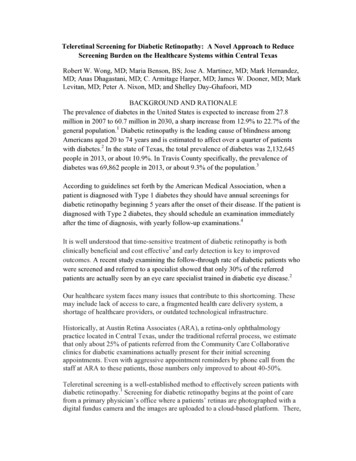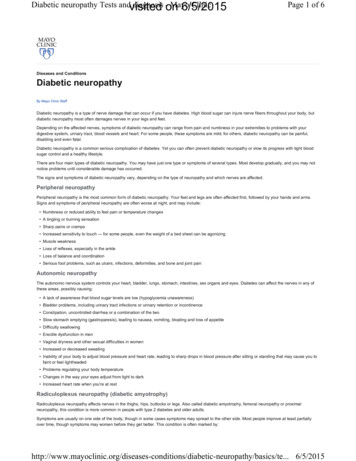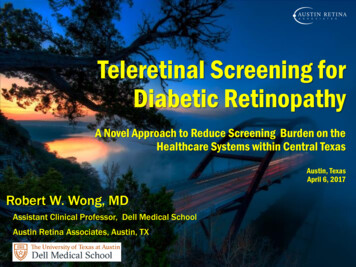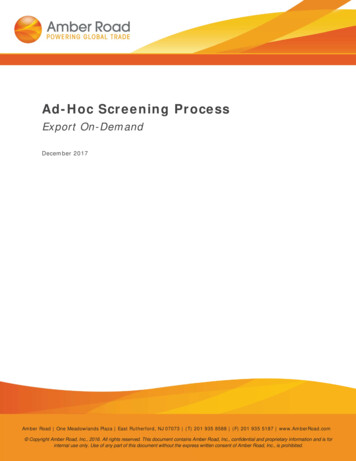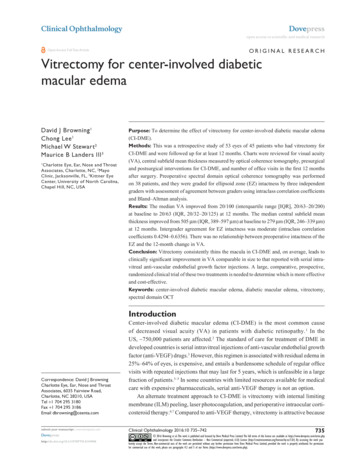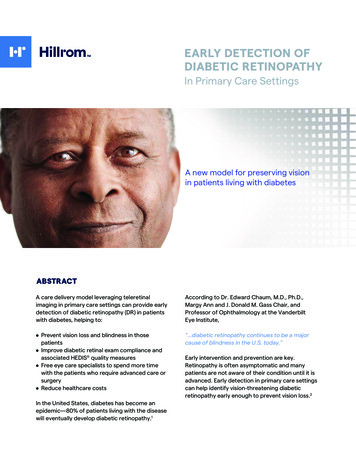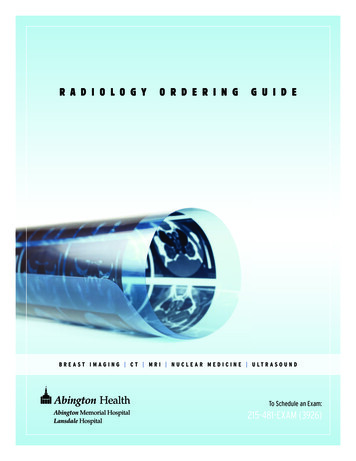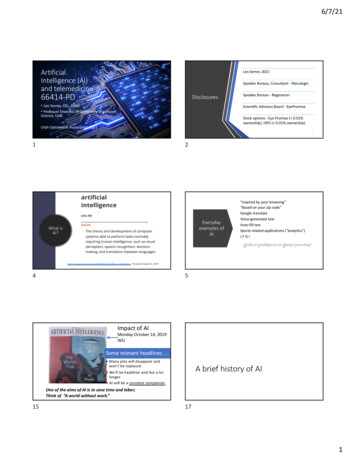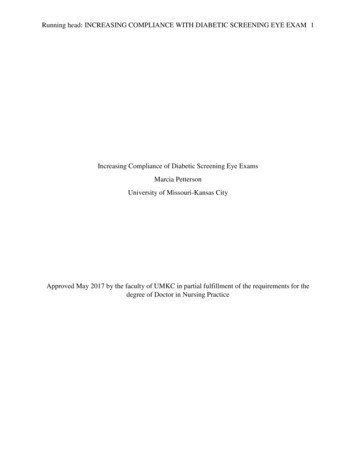
Transcription
Running head: INCREASING COMPLIANCE WITH DIABETIC SCREENING EYE EXAM 1Increasing Compliance of Diabetic Screening Eye ExamsMarcia PettersonUniversity of Missouri-Kansas CityApproved May 2017 by the faculty of UMKC in partial fulfillment of the requirements for thedegree of Doctor in Nursing Practice
INCREASING COMPLIANCE WITH DIABETIC SCREENING EXAMS 2017Marcia PettersonAll Rights Reserved2
INCREASING COMPLIANCE WITH DIABETIC SCREENING EXAMS3AbstractDiabetic retinopathy is one of the principal causes of vision loss in middle-age and older adultsworldwide. This quasi-experimental study examined the impact of patient diabetic retinopathyeducation and eye exam screening card on compliance with annual diabetic eye screening.About 40 participants ranging in ages from 18-80 years of age diagnosed with type 2 diabetesand without having an eye screening exam in the past two years were recruited from a familypractice clinic in an underserved community in the Midwest. Outcome measures werecompleted eye screening exams and knowledge pertaining to diabetic retinopathy. Screeningresults were compared to a retrospective non-intervention group, and knowledge was comparedpre- and post- education within the intervention group. The results showed that 30.8% of theparticipants completed an eye screening exam by returning the screening card. Using a Fisher’sExact test and a McNemar test, there was an improvement in diabetic retinopathy knowledgefrom pre- to post-test in one question along with improvement of knowledge in two questions butnot statically significant due to the small sample size. This project will foster awareness topatients about the positive consequences of compliancy with prevention measures, specifically inregards to diabetic retinopathy.Keywords: diabetic retinopathy, compliance, eye screening exam, type 2 diabetes, barriers
INCREASING COMPLIANCE WITH DIABETIC SCREENING EXAMS4IntroductionDiabetes is a disease noted by increased levels of blood glucose as a consequence toproblems in insulin production, insulin utilization, or both (Centers for Disease Control [CDC],2014). Currently, over 29 million individuals are diagnosed with diabetes in the United States(US), and with the increasing obesity rates, lengthened life expectancy, as well as individualracial and ethnic make-up, the overall trend of diabetes is projected to be 44.1 million by 2034(Center for Disease Control [CDC], 2014; Paksin-Hall, Dent, Dong & Ablah, 2012).Diabetic retinopathy, a complication commonly seen in patients diagnosed with diabetes,is one of the principal causes of vision loss worldwide, a main reason of vision impairment inpatients between the ages of 25 to 74 years of age, and the major cause of new cases of legalblindness in the work-age Americans (Frasier & D’Amico, 2015; American Academy ofOphthalmology Retina/Vitreous Panel, 2014). The frequency of occurrence for retinopathy forall adults with diabetes 40 years of age or older in the United States is 28.5%, or over fourmillion people, and estimated at 34.6% or 93 million people worldwide (American Academy ofOphthalmology Retina/Vitreous Panel, 2014).As the diabetes epidemic has not yet reached peak incidence, the number of Americansafflicted by vision-threatening diabetic retinopathy is expected to double to over 14 million bythe year 2050 with the Hispanic American population experiencing the greatest increase of morethan three-fold from 1.2 million to 5.3 million by 2050 (National Eye Institute, 2015). In thestate of Kansas, 18.1% of the population is diagnosed with diabetic retinopathy and only 78.4%of the population over the age of 40 has reported receiving a dilated eye exam (Centers forDisease Control, 2015).Diabetic retinopathy can affect all ethnicities diagnosed with diabetes. In 2012, 68% ofthose diagnosed with retinopathy were Caucasian (National Eye Institute, 2015). In the more
INCREASING COMPLIANCE WITH DIABETIC SCREENING EXAMS5severe vision threatening cases, those of Hispanic ethnicity were twice as likely, and in AfricanAmerican three times as likely than in the Caucasian population (National Eye Institute, 2016).Early detection, accurate diagnosis, and timely treatment are methods to dramatically decreasethe incidence of vision loss related to diabetic retinopathy (Zimmer-Galler et al., 2015). Theprofessional organizations of American Academy of Ophthalmology, American DiabetesAssociation, and the CDC’s National Eye Institute acknowledge the minimum requirement of anannual retinal evaluation for patient with diabetes, but despite these recommendationsindividuals are still not receiving the recommended eye care (Zimmer-Galler et al., 2015; PaskinHall, Dent, Dong & Ablah, 2012).Problem Statement and PurposeIn the prevention of severe vision loss due to diabetic retinopathy, it is recommended thatpatients maintain strict blood glucose control and have regular screening of the ocular fundus(Frasier & D’Amico, 2015). In the earliest stages, diabetic retinopathy may not demonstrate anyvisual impairment or vision loss therefore monitoring eye disease with dilated fundusexamination (DFE) is imperative in the prevention of vision loss (Paksin-Hall et al., 2012). Inthe US, approximately half of the population that are diagnosed with diabetes are screenedannually for retinopathy (Zimmer-Galler et al., 2015). The annual healthcare cost for diabetesrelated vision lost is estimated at 500 million dollars (CDC, 2015) and rises when patientspresent for eye care late in their disease course due to the delay in the diagnosis of diabetes, orlack of symptom presentation (Zimmer-Galler et al., 2015). Locally, in Wyandotte County,Kansas 12.9% of the county population has been diagnosed with diabetes (Mid-AmericaRegional Council, 2013).
INCREASING COMPLIANCE WITH DIABETIC SCREENING EXAMS6The purpose of this Doctor in Nursing Practice (DNP) project was to attempt to increasethe compliance rates of yearly eye screening exams and foster a reduction in incidence ofdiabetic related blindness. The goal of this quasi-experimental study was to evaluate the impactof patient diabetic education and eye screening card on compliance with annual diabetic eyescreening (see Appendices A for definition of terms).Facilitators and BarriersThe facilitators for this DNP project included the student investigator, who is anAdvanced Practice Registered Nurse (APRN) in a collaborative practice within a family practiceclinic setting of an underserved population, and the collaborating physician who is supportive ofthe project. Barriers included lack of transportation by the patient within the underservedcommunity, inability to obtain eye screening appointment in a timely manner, or a decrease incompliance with return of screening card. Screening card use was promoted providing a selfstamped and self-addressed postcard that participants needed to mail. This project can besustainability if successful as this type of intervention can be applied to other chronic diseasemanagement to improve compliance.PICOTVarious factors can influence the compliance to obtaining DFE. This project integrateddiabetic retinopathy education along with screening cards to increase compliance with screeningeye exams. The PICOT question was, “in the diabetic patient population, does providingdiabetic retinopathy education and a screening/reminder card increase the compliance rates ofdiabetic retinopathy eye screening exams compared to diabetic patients who have only verbalreminders to obtain diabetic eye screening exams during a 4 month period at a primary caresetting.”
INCREASING COMPLIANCE WITH DIABETIC SCREENING EXAMS7Literature SearchThis integrative review explores evidence on factors contributing to patient noncompliance with annual diabetic eye screening exams. The following terms were used for thesearch: diabetic retinopathy, patient compliance, annual eye examinations, dilated eyeexamination, diabetes, practice guidelines, barriers, Type 2 diabetes, and Type 1 diabetes. Thedatabases used to search for studies and guidelines included Cumulative Index to Nursing andAllied Health (CINAHL), PubMed, Cochran, American Academy of Ophthalmology, andAmerican Academy Diabetes Association.From the search, 22 research studies were discovered. The articles ranged from 2007 tothe present. Exclusion criteria for studies included older then 2007, non-English language, focuson management of retinopathy, and screening intervals. The research studies were comprised oftwo evidence-based practice guidelines, four cross-sectional, five cohort studies, four qualitativestudies, two systematic reviews with on meta-analysis, and seven randomized control studies. Inthese research studies, two were evidence level I, two level II, one level III, thirteen level IV,four level V, and one level VI as defined per Melnyk (2015; Melnyk & Fineout-Overholt, 2015).Synthesis of EvidenceDiabetic retinopathy that is not detected or treated in its early stages can advance tovision loss. Approximately 50-70% of individuals diagnosed with diabetes receive annual DFE(Paksin-Hall et al., 2012). In patients with type 1 diabetes professional associations recommendthat the initial dilation and comprehensive eye examination be performed within five years aftera confirmed diagnosis of diabetes (American Diabetes Association [ADA], 2016; AmericanAcademy of Ophthalmology Retina/Vitreous Panel, 2014). For patients with type 2 diabetesguidelines recommend that patients be referred at time of their diagnosis for their initial dilation
INCREASING COMPLIANCE WITH DIABETIC SCREENING EXAMS8and comprehensive eye examination due to the uncertainty of the duration of elevated bloodsugars (ADA, 2016; American Academy of Ophthalmology Retina/Vitreous Panel, 2014).Studies have revealed common barriers to patient compliance with eyes exams such asshorter duration of disease (Sheppler et al., 2014; Saadine, Donald, Fong & Yao, 2008; Scanlonet al., 2015; MacLennan, et al., 2014), and lack of access (Linenmeyer et al., 2014; Hatef et al.,2015; Lee et al., 2014; Gower et al., 2013; Dorsey, et al., 2007; Paskin-Hall et al., 2012; Chou etal., 2014; MacLennan et al., 2014; Creuzot-Garcher et al., 2010; Taylor et al., 2007). Otherstudies have shown a relationship between compliance with yearly eye exams and lack ofeducation related to diabetic retinopathy (Van Eijk, Blom, Gussekloo, Polak & Groeneveld,2011; Gazmararian et al., 2009; Nam, Chelsa, Stotts, Kroon & Janson, 2011; Jones, Walker,Schechter & Blanco, 2010; Sloan, Yashkin & Chen, 2014; Brunisholz et al., 2014). Finally,studies have revealed that minimal or no support from healthcare provider-provider relationshipnegatively affects the compliance of diabetic retinopathy screening exams (Williams et al., 2009;Lindenmyer et al., 2014; Nam et al., 2010; Gherman et al., 2011; see Appendices B for synthesisof evidence table).Lack of AccessLack of access is a common barrier to the nonadherence of eye screening exams. Thelargest single problematic issue related to nonadherence is transportation including inability toafford or locate transportation (Lindenmeyer et al., 2014). Barriers to nonadherence can also beassociated with sociodemographic factors, health insurance coverage, medication, visualimpairment, and geographic accessibility to an ophthalmologist (Chou et al., 2014; Dorsey et al.,2007; MacLennan et al., 2014; Creuzot-Garcher et al., 2010).
INCREASING COMPLIANCE WITH DIABETIC SCREENING EXAMS9A major issue in diabetic retinopathy control is providing resources for individuals whomay or may not have signs of vision impairment (Hatef et al., 2015). Hatef et al. (2015)examined performance rates of managed care organizations annual diabetic eye screening in theMedicaid population and identified barriers. The evidence showed that 46% (n 1736) in 2010and 64% (n 3261) in 2012 completed an annual eye exam supporting that a higher compliancerate is associated with increased access (Hatef et al., 2015). The increase in completed examswas likely due to incentives offered to the primary care offices for implementing the anonmydriatic funduscopic camera during the patient’s visit in the primary care clinic (Hatef etal., 2015). The creation of same day eye exam appointments would improve attendance ratessince patients are already at the primary care provider’s office (Gower et al., 2013).Duration of DiseaseAmong studies that measured compliance barriers, patients who are older in age,experience prolonged duration of diabetes, have poorer vision, or have an increase in the severityof their retinopathy show a positive relationship with compliance of eye screening exams alongwith follow-up of their eye disease (Saadine et al., 2008). Prior studies revealed consistentresults by showing a direct relationship with the duration of diabetes and eye exam adherence,and the age range most at risk for noncompliance with eye exams is ages 18-35 (Sheppler et al.,2014; MacLennan et al., 2014).Lack of EducationInitially eye involvement in diabetes is essentially symptom free; therefore, patients maynot understand that annual eye examination are essential (Creuzot-Garsher et al., 2010). VanEijk et al. (2011) revealed that decreased awareness about the damaging effects of diabeticretinopathy on visual acuity, anxiety over the results of the eye screening exam, and perceived
INCREASING COMPLIANCE WITH DIABETIC SCREENING EXAMS10lack of usefulness at patients’ age (patients aged 70 years) influenced obtaining an eyeexamination. Denial is also a key factor that inhibits adherence whether related to prevention ofcomplication or self-management of the disease (Gazamrarian et al., 2009). Evidence indicatesthat patients failed to believe that consequences will happen and that patients expressedconfusion about education material content (Gazamrarian et al., 2009).The reviewed studies indicated that common barriers individuals might have in relation todiabetes management include misconceptions regarding the seriousness of the disease, lack ofunderstanding about the disease and possible complications; these barriers can contribute topatients not obtaining proper screening for diabetic complications such as diabetic retinopathy(Nam et al., 2010). Sloan et al. (2014) explored the gaps in receipt of regular eye exam, and thefindings supported the claim that lack of patient’s knowledge in regards to monitoring by eyecare professional is critical to patients receiving annual eye exams, even prior to diabetes-relatedeye complication diagnosis.Brunisholz et al. (2014) conducted a study on diabetic education and found thatstandardized Diabetic Self-Management Education (DSME) is strongly associated withimproving diabetes outcomes and increasing adherence. Similar studies have supported thisevidence showing that time spent participating in diabetic education activities increased thelikeliness of patients obtaining a diabetic eye screening exam (Jones et al., 2010). Also, clinicianfactors may contribute to the decrease in compliance of eye exams. Factors include the failure tofollow evidence-based treatment guidelines, beliefs, knowledge and attitudes, communicationand patient-clinician interactions (Nam et al., 2010).
INCREASING COMPLIANCE WITH DIABETIC SCREENING EXAMS11Patient-Clinician RelationshipPatient-clinician relationships are built through communication and trust. Patients andclinicians differ significantly in their awareness, knowledge, and attitudes, which may lead toconflict, decreased clarity, and poor outcomes (Nam et al., 2010). In a systematic review, Namet al. (2010) found that patient’s disease perceptions are influenced by their healthcare provider.Unfortunately, many patients report challenging obstacles associated with the provider such aslack of adequate communication, tools, and skills on counseling and decision-making oneffective treatment which are factors associated with poor compliance (Nam et al., 2010).Gherman et al. (2011) performed a meta-analysis which investigated the relationshipbetween knowledge related to diabetes and adherence to diabetic regimens and discovered thatahigher level of knowledge related to increased adherence to diabetes regimens (Gherman et al.,2011). In another study which explored factors that contribute to patient retinopathy screening,results showed that communication between practice staff, as well as screeners and patients, staffperceptions of non-attenders, and medical staff communication influence adherence to diabeticeye screening exams (Lindenmeyer et al., 2014).Nonadherence regimens are complicated and involve relationships among patient, healthcare clinicians, and community (Williams et al., 2009). A study, which applied the selfdetermination theory (SDT) to predict adherence and outcomes in diabetic patients confirmedthat the perception of the ability to act independently in the management of their own diabetescare from the health care provider was positively associated with the self-regulation ofmedication use and competence for self-management (Williams et al., 2009). Studies suggestthat the effective use of tools such as time, resources, training, feedback and incentives toenhance the use of evidence-based guidelines leads to the ability to improve clinicians’
INCREASING COMPLIANCE WITH DIABETIC SCREENING EXAMS12communication skills and ultimately patients’ health outcomes (Nam et al., 2011). At this timestudies have examined reasons for noncompliance rather than how to increase the compliance ofyearly eye exams.TheoryBeliefs can be strongly associated with adherence. The model that was utilized for thisDNP project was the Health Belief Model (HBM; Hochbaum, Rosenstock & Kegels, 1952).This theory addresses problem behavior that evokes health concerns (Glanz, Burke & Rimer,2014). The six main constructs of HBM include perceived susceptibility, perceived severity,perceived benefit, perceived barriers, cue to action and self-efficacy (Glanz, 2014). Gherman, etal (2011) measured individual beliefs, and perceptions, related to diabetes and the associationbetween cognitive factors and blood glucose levels or other adherence behaviors. The resultsshowed that self-efficacy, patient’s trust and confidence in their health care provider, and theperceived consequences related to their choices are strongly associated with adherence (Ghermanet al., 2011).HBM can be a useful tool when developing strategies that apply to noncompliancesituations (Glanz, 2014). Patients must believe that the advised treatment and/or screeningguidelines will reduce their risk without negative outcomes or excessive difficulty (Glanz, 2014).The education created for this DNP project addressed the issue of noncompliance by increasingpatient’s knowledge about disease process and preventative measures targeted toward diabeticretinopathy along with the importance of regular screening eye exams in the prevention of visionloss (see Appendices C for theory to application diagram).
INCREASING COMPLIANCE WITH DIABETIC SCREENING EXAMS13IRB Approval, Site Approval, Ethical Issues and FundingThe University of Kansas Health System Institutional Review Board deemed this projectas quality improvement. A site agreement was obtained through the project site clinic. As astudent investigator and provider at the clinic, there was not a conflict of interest of as the resultsof this study can be applied to a different clinic. The voluntary participation process included aninformation letter describing the project and asking the individual to participate in the project.Confidentiality was maintained by assignment of a code to each participant. Patientdemographics of name, age, date of birth and ethnicity were entered into RedCap. Funding forthis project included volunteered time and the student investigator sought small grants throughthe American Association of Nurse Practitioners (AANP), American Diabetes Association(ADA), and National Institute of Diabetes and Digestive and Kidney Disease (NIDDK; seeAppendices D for cost table of this project, Appendices E for project timeline).Setting and ParticipantsThe setting for this project was an established family practice clinic that is in anunderserved community in Kansas City, Kansas providing healthcare to over 2,000 patients peryear. The number of participants for this project was 30-40 patients in the intervention group.The sampling method for the intervention group was consecutive sampling. The collaboratingphysician and the student investigator performed a computer generated chart audit for patientswith type 2 diabetes using ICD-10 code E11.9. Inclusion criteria for this project includedpatients with the diagnosis of type 2 diabetes, age range of 18-80 years of age, and no eyescreening exam within in the past two years documented in the electronic medical record.Exclusion criteria included individuals with the diagnosis of type 1 diabetes, under the age of 18and over the age of 80, eye screening within the last year, and non-English or non-Hispanic
INCREASING COMPLIANCE WITH DIABETIC SCREENING EXAMS14speaking patients. The control group data, which addressed diabetes and eye care, was obtainedfrom retrospective data made available quarterly through the University of Kansas HealthSystem.Evidence-Based InterventionGazmararian et al. (2009), utilized focus groups to discover both barriers andopportunities for improving the care and management of diabetes in the underserved population.Similar studies discovered that patients often forget about their appointments for yearly eyeexam or feel the exam is not necessary because of the absence of vision symptoms (Chou et al.,2013; Gower et al., 2009). The intervention for this DNP project included diabetic retinopathyeducation in conjunction with a reminder/screening card. The education included the diseaseprocess, treatment, and prevention of the disease. The education booklet, Diabetic Eye DiseaseAn Educator’s Guide, which consists of information related to diabetic retinopathy, was providedby the United States Department of Health and Human Services Nation Eye Institute (NationalEye Institute, 2005; see Appendices F for education material).The intervention began with the recruitment process. During a one week period thestudent investigator who is an APRN met with her collaborative physician and performed acomputer generated chart audit using ICD-10 code E11.9 via the collaborative physician’spatient panel. A range of 30-40 patients by consecutive sampling was selected fromclients witha clinic appointment during between September-December 2016, taking into consideration bothinclusion and exclusion factors. Each potential participant was provided with an informationalletter discussing the project and asking if they would like to participate in this project.Participants were assigned a code number after consent was obtained, and then the studentinvestigator collected demographic data including age, gender, date of birth, and ethnicity.
INCREASING COMPLIANCE WITH DIABETIC SCREENING EXAMS15The second phase of this intervention was the application of the intervention. In theapplication process each participant was asked to complete eight true or false questions related tothe individual’s knowledge about diabetic eye disease prior to the education intervention. Next,the participants received an individual education booklet related to diabetic retinopathy duringthe clinic visit. The student investigator provided education to each individual participant duringtheir regular scheduled clinic visit. The participants were then asked to complete thequestionnaire again along with two new questions that assessed their readiness to make an eyescreening appointment. If participants revealed they were not ready to make an eye appointment,they were directed to the next question asking for a reason why they were not ready to make theappointment. Participants that expressed readiness to make an appointment were given thepostcard and instructions. Participants were instructed to make and obtain their eye screeningexam within six weeks from the initial clinic visit and that the eye care specialist must sign theback of the card. Data was collected over a 4 month period. Finally, using the statistical dataprogram SPSS, an analysis will be performedThe final step was to retrieve retrospective data from the previous quarter prior to thequality improvement intervention on the compliance rates for diabetic eye screening exams at theclinic site. This data is performed quarterly through chart audits by the University of KansasHealth System for outcome compliance related to patient centered medical home standards. Thisaggregate de-identified data is made accessible to providers and discussed at quarterly meetingsthat focus on patient improvement. Finally, the retrospective non-intervention data on eyescreening rates was compared to the intervention group data (see Appendices G for logic modeland H for intervention diagram).
INCREASING COMPLIANCE WITH DIABETIC SCREENING EXAMS16Change ModelThe change theory that supported this DNP project is the Transtheoretical Model ofBehavior Change (Prochaska & DiClemente, 1983). This theory is used to assist inunderstanding individual’s progression toward establishing and managing health behaviorchange for maximum health (Gillespie & Lenz, 2011). The theory suggests that health behaviorchange can be strengthened by advancing knowledge and confidence, growing patient’sindividual skills and competence, and improving social facilitation (Ryan, 2009). The key to theuse of this theory in a practice setting is to evaluate the individual’s phase and then inform andencourage the patient to advance forward to the action, maintenance and termination stages(Gillespie & Lenz, 2011).The EBP framework used for this project is the Model for Evidence-Based PracticeChange (Rosswurm & Larrabee, 1999). This model integrates principles of qualityimprovement, use of team working tools and evidence-based translation strategies to promoteadoption of a new practice (Melnyk & Fineout-Overholt, 2015). Locating the best evidence,analyzing the evidence, designing a practice change, and applying and assessing the change arethe keys steps to this model (Melnyk & Fineout-Overholt, 2015). Evidence supports thatindividuals are not obtaining regular yearly eye screening exams due to lack of knowledge aboutthe disease. This DNP project focused on education, and successes can be applied to everydaypractice and other chronic disease.Study DesignThe study design for this project was a quasi-experimental design, pre-post knowledgewithin the prospective intervention group and post only eye care exam completion between theintervention group and retrospective control group. The participants for the intervention group
INCREASING COMPLIANCE WITH DIABETIC SCREENING EXAMS17were obtained through consecutive sampling. The independent variable was the education withthe screening cards, and the measured outcome was the impact on patients obtaining their eyescreening exam and knowledge of diabetic retinopathy.ValidityThe aspect in the project that promotes internal validity is that the educational materialprovided follows recommended guidelines for diabetic eye care from the American DiabetesAssociation, National Eye Institute and American Academy of Ophthalmology Retina/VitreousPanel. The diabetic retinopathy knowledge test that was used as a secondary measure does nothave established reliability in assessing patient’s knowledge, but content does have validity asthe test was created from the National Eye Institute (National Eye Institute, 2000). Externalvalidity is promoted in this project by using a sample of type 2 diabetic ranging in ages 18-80years of age although generalization may be limited due to exclusion of patients who arenoncompliant with their yearly diabetic eye exam.Measured OutcomesIn this DNP project the primary outcome measured was the increase in compliance ratesof screening eye exams. This was measured by the amount of returned screening cards to theclinic and was compared to the retrospective data. A secondary outcome measured was theparticipant’s knowledge and was compared pre- and post-education within the intervention groupby using a diabetic retinopathy knowledge test.Measurement InstrumentsThe first instrument of measurement was the screening card. The screening card is a selfaddressed, self-stamped postcard that each participant received after the education interventionwas completed. This measurement was obtained in the amount of cards that were signed by the
INCREASING COMPLIANCE WITH DIABETIC SCREENING EXAMS18eye care specialist and returned to the clinic. This measurement assisted in the validation of theimpact of the intervention on eye screening exam. One weakness to this tool was that a patientmay have completed their eye exam, but the screening card may not be returned, or screeningcard may have been lost. Also, participants may have forgotten to have the card signed by theireye care specialist during their eye exam.The second instrument that was used for this DNP project was questions obtained fromthe diabetic retinopathy knowledge test. The test was developed by the National Eye Institute toassess diabetic eye disease knowledge, and the institute has granted permission for use andreconfiguration of the questionnaire. This test otherwise known as “Eye-Q Test” is a 10true/false questionnaire to assess an individual’s knowledge of diabetic retinopathy and eyedisease (National Eye Institute, 2000). For the purpose of this project, two questions wereomitted from the pre- and post-test. Two questions were added to the post-test addressing theparticipant’s readiness to schedule an eye exam. If participant answered no to the readinessquestion, then he/she was directed to the next question asking why. This measurement may helpidentify b
University of Missouri-Kansas City . Approved May 2017 by the faculty of UMKC in partial fulfillment of the requirements for the degree of Doctor in Nursing Practice . INCREASING COMPLIANCE WITH DIABETIC SCREENING EXAMS 2 . The purpose of this Doctor in Nursing Practice (DNP) project was to attempt to increase .
